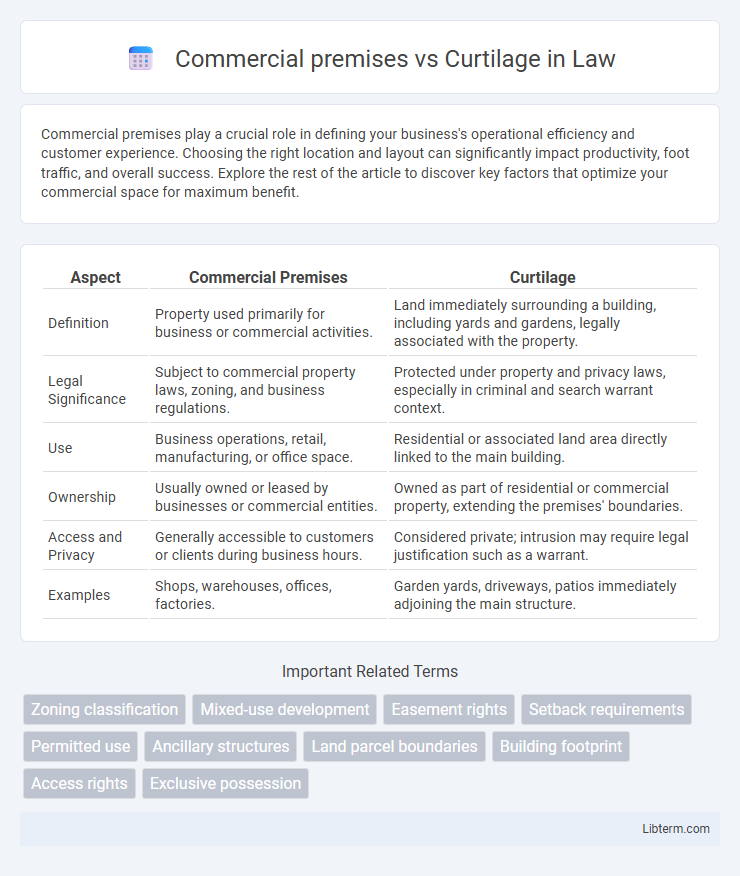Commercial premises play a crucial role in defining your business's operational efficiency and customer experience. Choosing the right location and layout can significantly impact productivity, foot traffic, and overall success. Explore the rest of the article to discover key factors that optimize your commercial space for maximum benefit.
Table of Comparison
| Aspect | Commercial Premises | Curtilage |
|---|---|---|
| Definition | Property used primarily for business or commercial activities. | Land immediately surrounding a building, including yards and gardens, legally associated with the property. |
| Legal Significance | Subject to commercial property laws, zoning, and business regulations. | Protected under property and privacy laws, especially in criminal and search warrant context. |
| Use | Business operations, retail, manufacturing, or office space. | Residential or associated land area directly linked to the main building. |
| Ownership | Usually owned or leased by businesses or commercial entities. | Owned as part of residential or commercial property, extending the premises' boundaries. |
| Access and Privacy | Generally accessible to customers or clients during business hours. | Considered private; intrusion may require legal justification such as a warrant. |
| Examples | Shops, warehouses, offices, factories. | Garden yards, driveways, patios immediately adjoining the main structure. |
Introduction to Commercial Premises and Curtilage
Commercial premises refer to buildings or spaces used primarily for business activities, including retail shops, offices, warehouses, and service centers. Curtilage encompasses the land immediately surrounding a building, associated with its use and protection, often affecting property rights and planning permissions. Understanding the distinction between commercial premises and their curtilage is crucial for legal, zoning, and security considerations.
Defining Commercial Premises
Commercial premises are defined as buildings or spaces primarily used for business activities, including retail stores, offices, warehouses, and factories. These premises are characterized by their operational purpose, distinct from residential or purely private properties, and often subject to specific zoning laws and business regulations. Curtilage, in contrast, refers to the land immediately surrounding a building that is used for the building's domestic purposes, excluding areas designated explicitly for commercial use.
Understanding the Concept of Curtilage
Curtilage refers to the land immediately surrounding a building, including any closely associated structures, which is considered part of the property for legal and zoning purposes. In commercial premises, understanding curtilage is crucial for defining boundaries, determining permissible land use, and ensuring compliance with local regulations. Proper identification of curtilage helps distinguish between areas intended for business operations and those considered external, affecting property rights and development potential.
Key Legal Distinctions
Commercial premises refer to buildings or spaces used primarily for business activities, while curtilage denotes the land immediately surrounding a property, considered part of the private domain for legal purposes. Key legal distinctions include property rights, zoning regulations, and scope of ownership, where curtilage often affects privacy and search warrant boundaries, unlike commercial premises governed by commercial real estate law. Understanding these differences is crucial for property disputes, law enforcement searches, and regulatory compliance.
Importance in Property Law
Commercial premises denote the physical spaces designated for business activities, directly impacting property valuation, zoning regulations, and lease agreements in property law. Curtilage refers to the land immediately surrounding a building, which holds significant legal protections related to privacy, trespass, and usage rights. Understanding the distinction between commercial premises and curtilage is crucial for accurate property delineation, enforcement of legal boundaries, and resolving disputes over land use and ownership rights.
Zoning and Land Use Implications
Commercial premises typically refer to buildings or structures designated for business activities within defined zoning districts, influencing allowable uses, building height, and density. Curtilage encompasses the land immediately surrounding a building, often subject to different zoning regulations affecting setbacks, landscaping, and ancillary uses. Understanding the distinction is crucial for land use planning, as commercial premises zoning governs primary operational functions while curtilage zoning can impact expansion, signage, and outdoor commercial activities.
Security and Privacy Considerations
Commercial premises require robust security measures such as surveillance cameras, access control systems, and alarm installations to protect assets and sensitive information. Curtilage, the area immediately surrounding a building, often demands tailored privacy considerations like fencing or landscaping to delineate private versus public spaces and prevent unauthorized access. Understanding the distinction aids in designing security protocols that address both the functional protection of commercial operations and the privacy needs of adjoining outdoor areas.
Impact on Business Operations
Commercial premises define the primary location where business activities occur, directly influencing operational efficiency, customer access, and compliance with zoning laws. Curtilage, referring to the land immediately surrounding a building, affects business operations by determining space for outdoor storage, signage, and potential expansion, while also impacting security measures and property boundaries. Understanding the legal distinctions between commercial premises and curtilage is crucial for optimizing space usage, managing liability risks, and adhering to local regulations that can affect overall business performance.
Case Studies and Legal Precedents
Legal distinctions between commercial premises and curtilage are clarified through cases such as *Katz v. United States* and *R v. Jones* which emphasize expectations of privacy and property boundaries in commercial law. Courts consistently apply criteria like direct control, functional use, and proximity to determine curtilage status, affecting rights related to search, seizure, and liability. Detailed analysis of precedents such as *United States v. Dunn* highlights how commercial curtilage boundaries influence regulatory compliance and dispute outcomes.
Choosing the Right Option for Your Needs
Choosing between commercial premises and curtilage depends on your specific business requirements and legal considerations. Commercial premises typically offer structured spaces designed for retail, office, or industrial use, providing essential facilities and compliance with zoning laws. Curtilage offers more flexibility with outdoor space often adjacent to buildings, suitable for businesses needing storage, loading areas, or potential expansion, but may involve different regulatory restrictions.
Commercial premises Infographic

 libterm.com
libterm.com